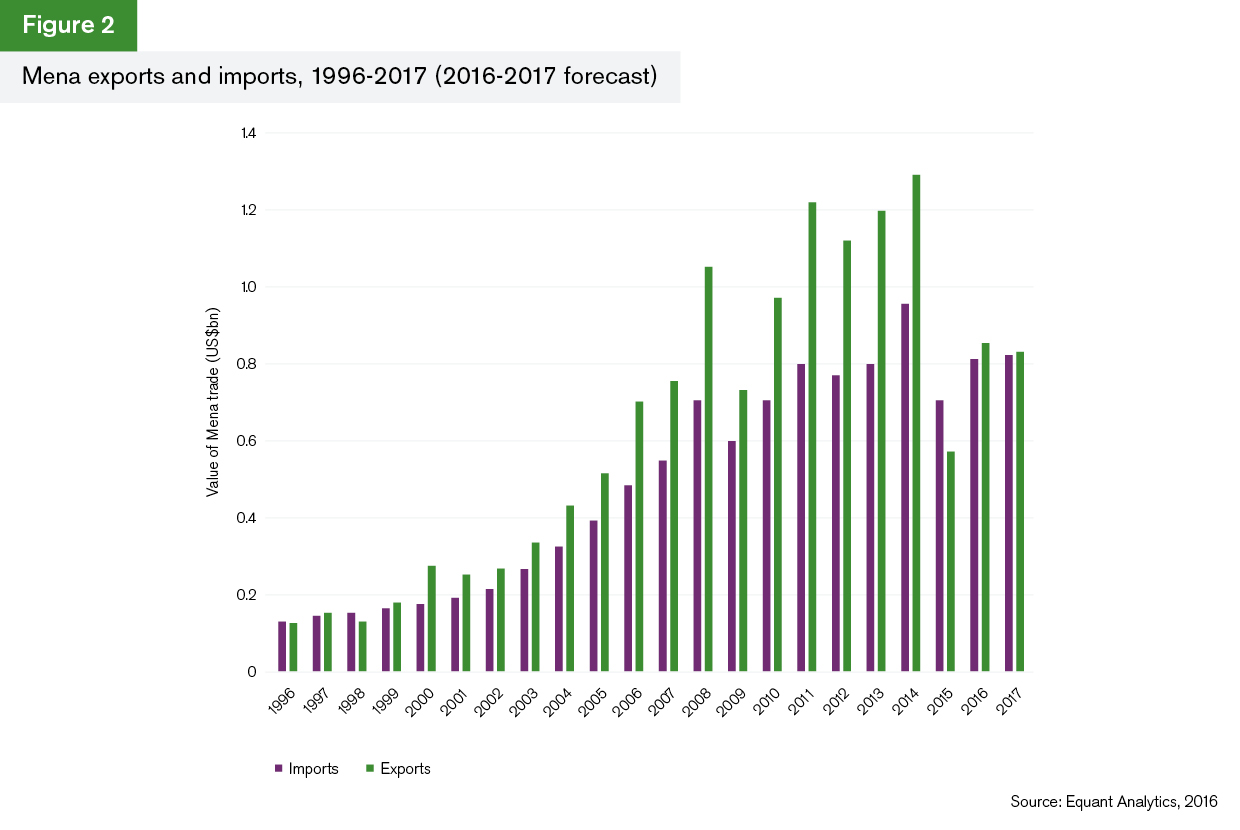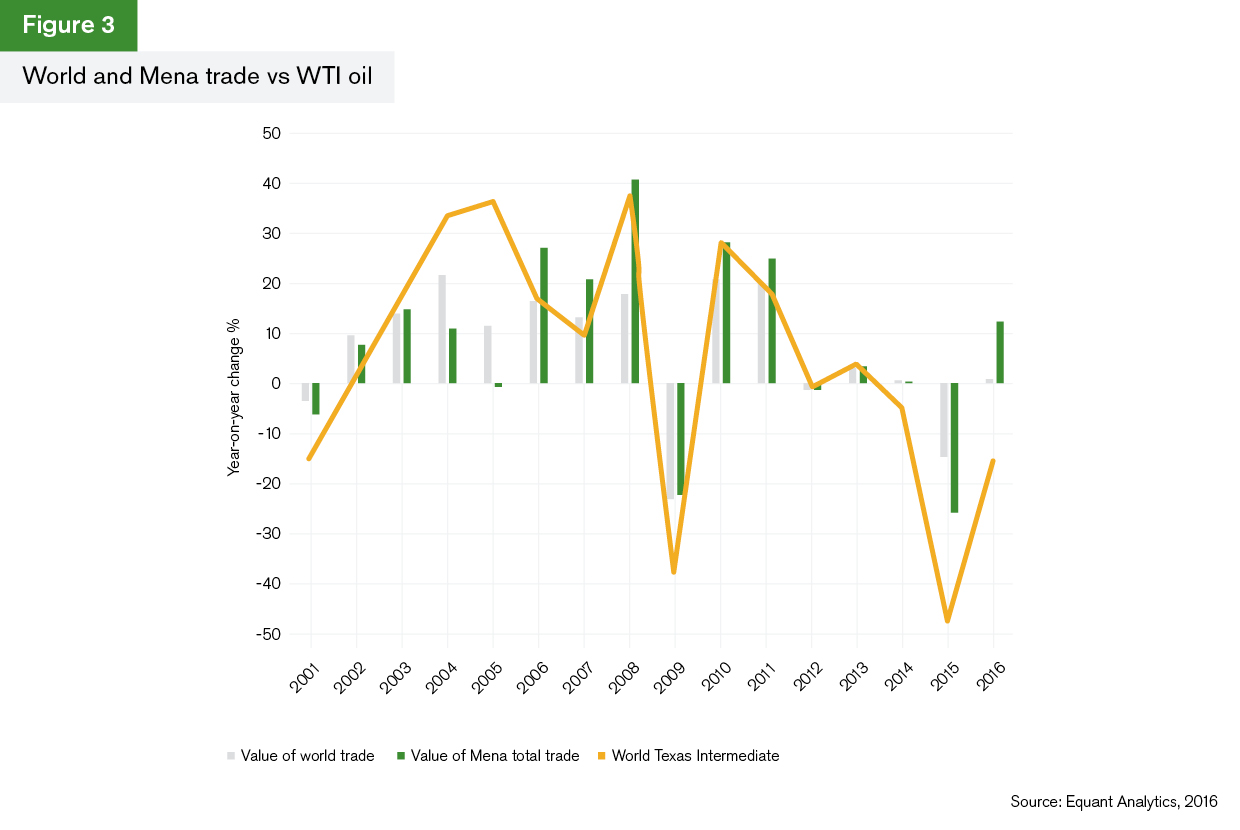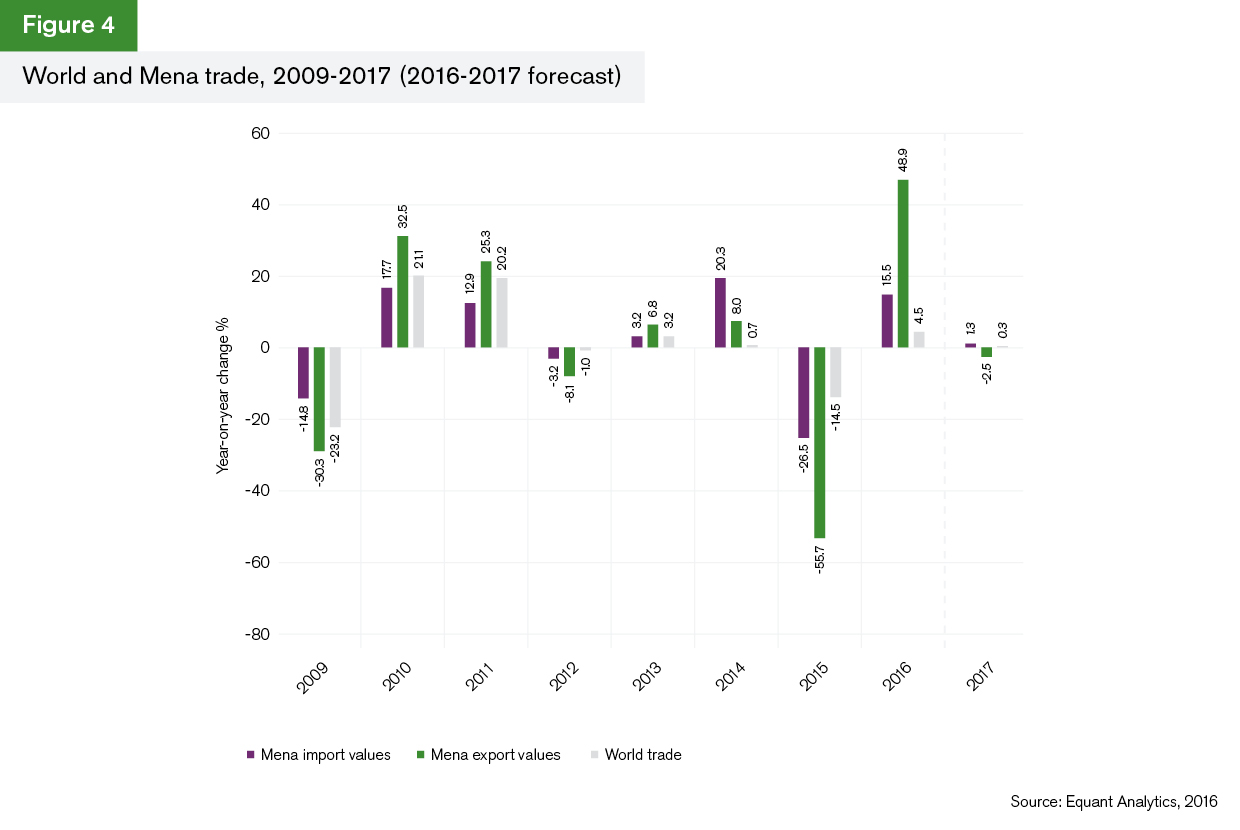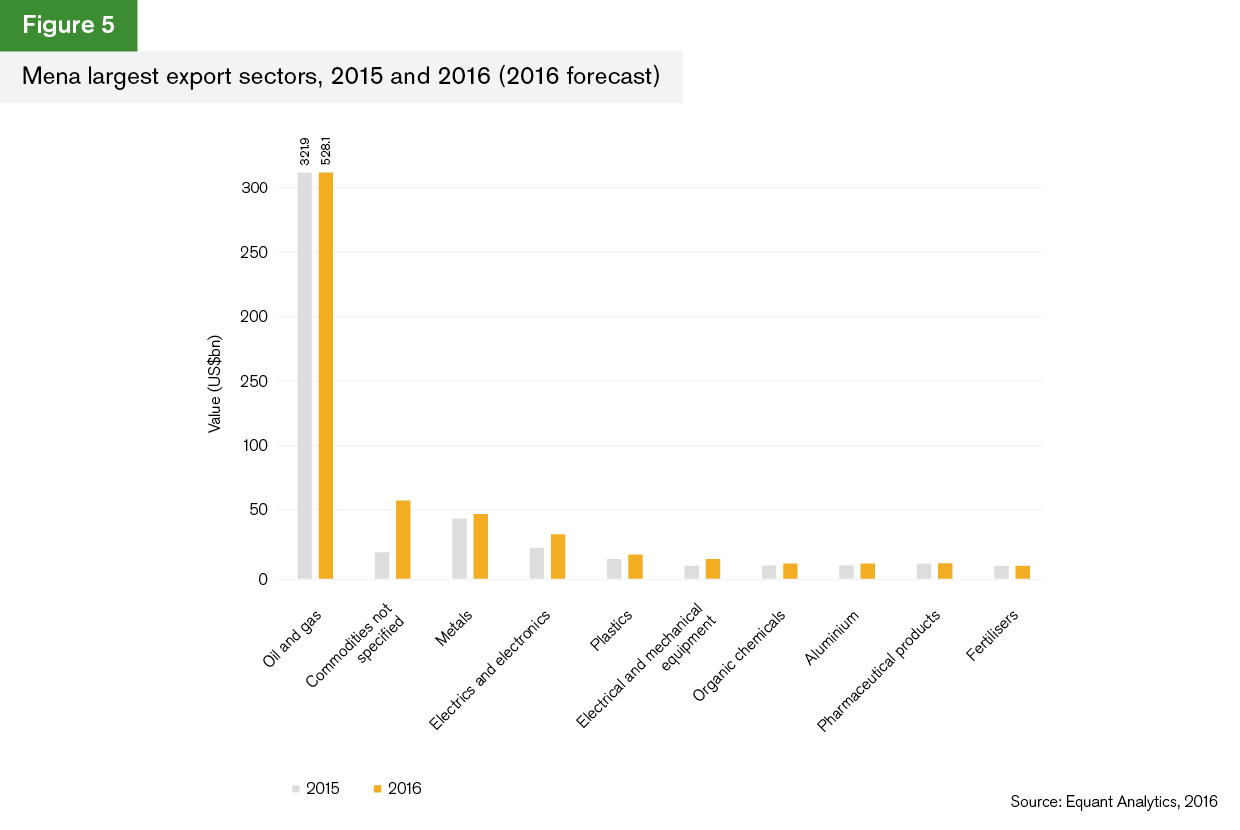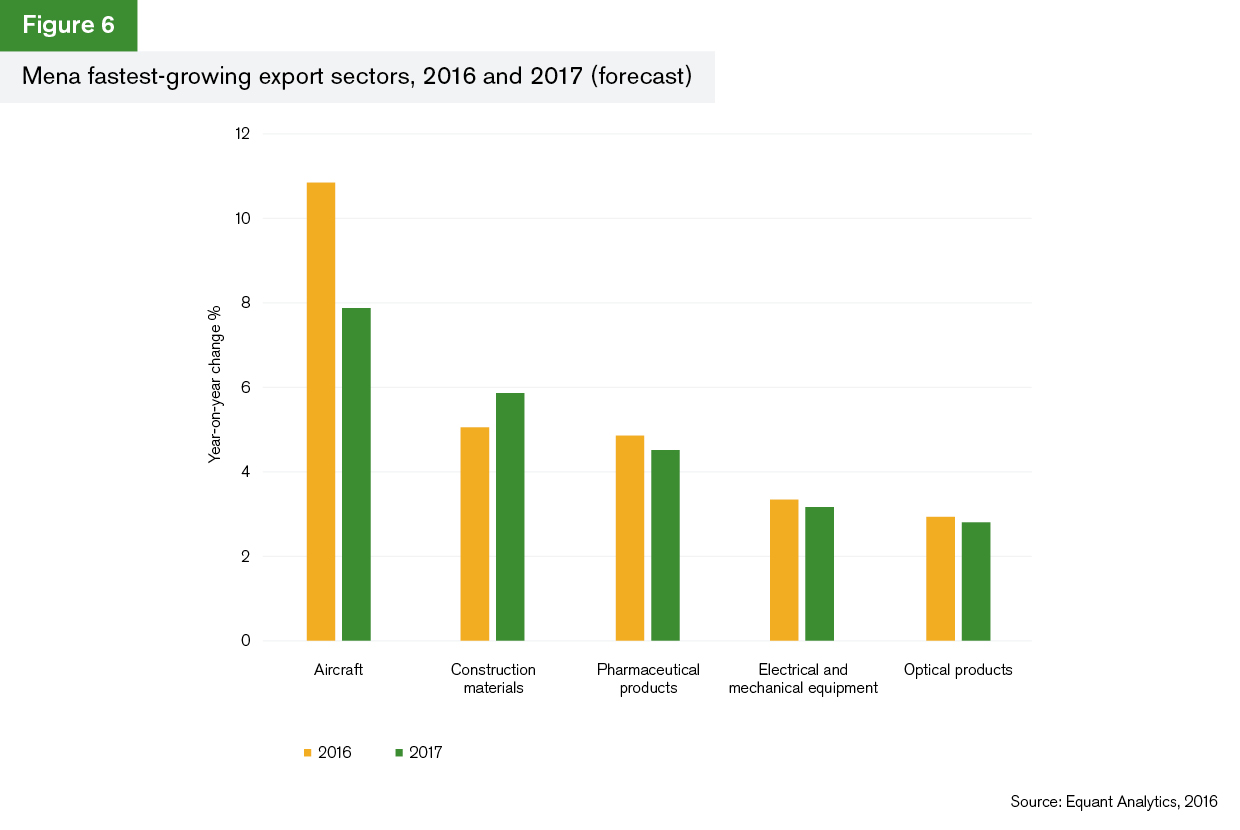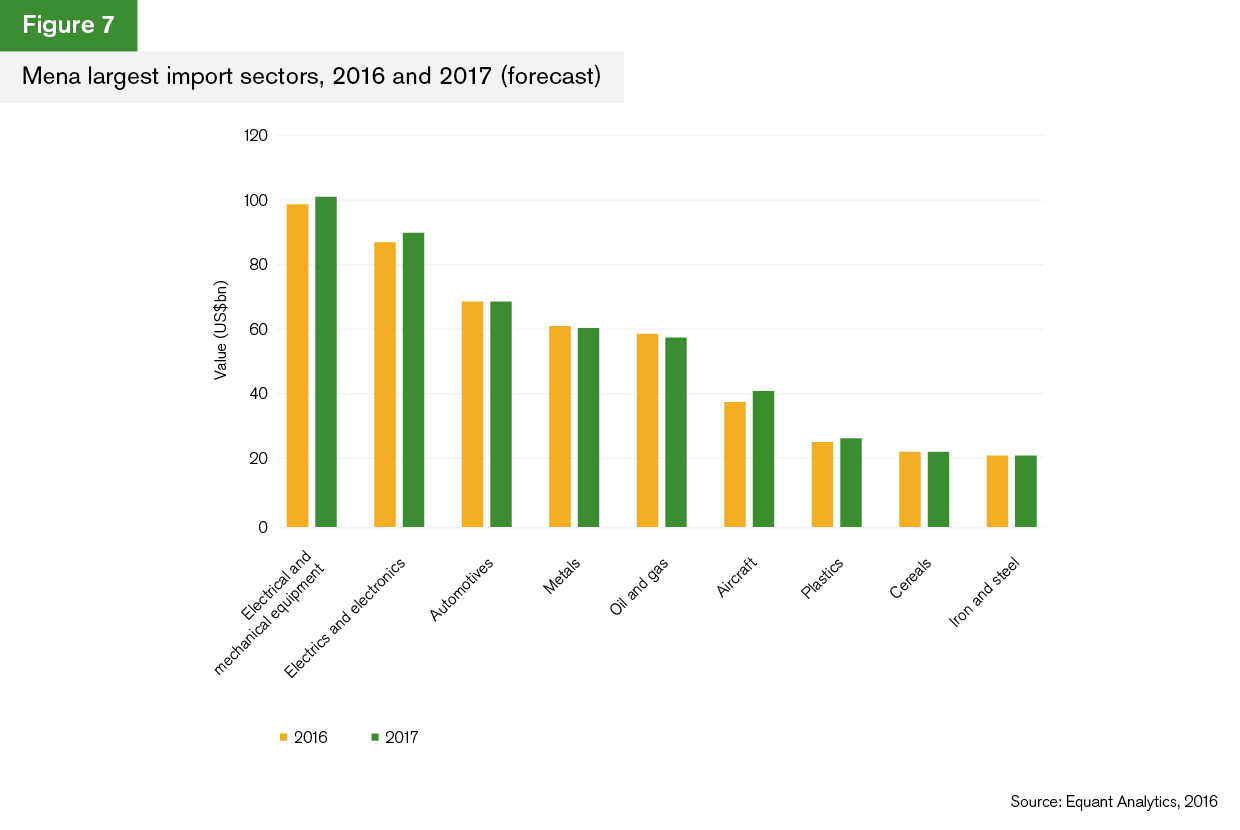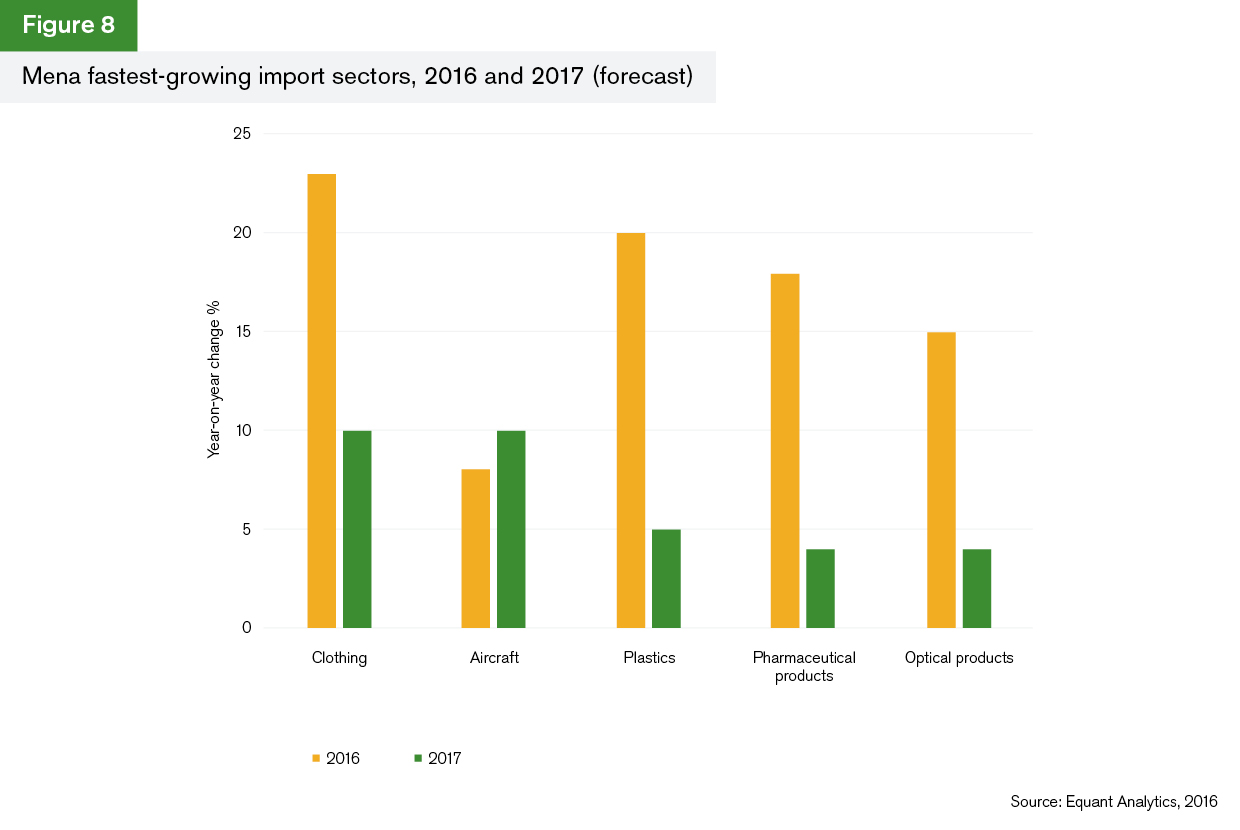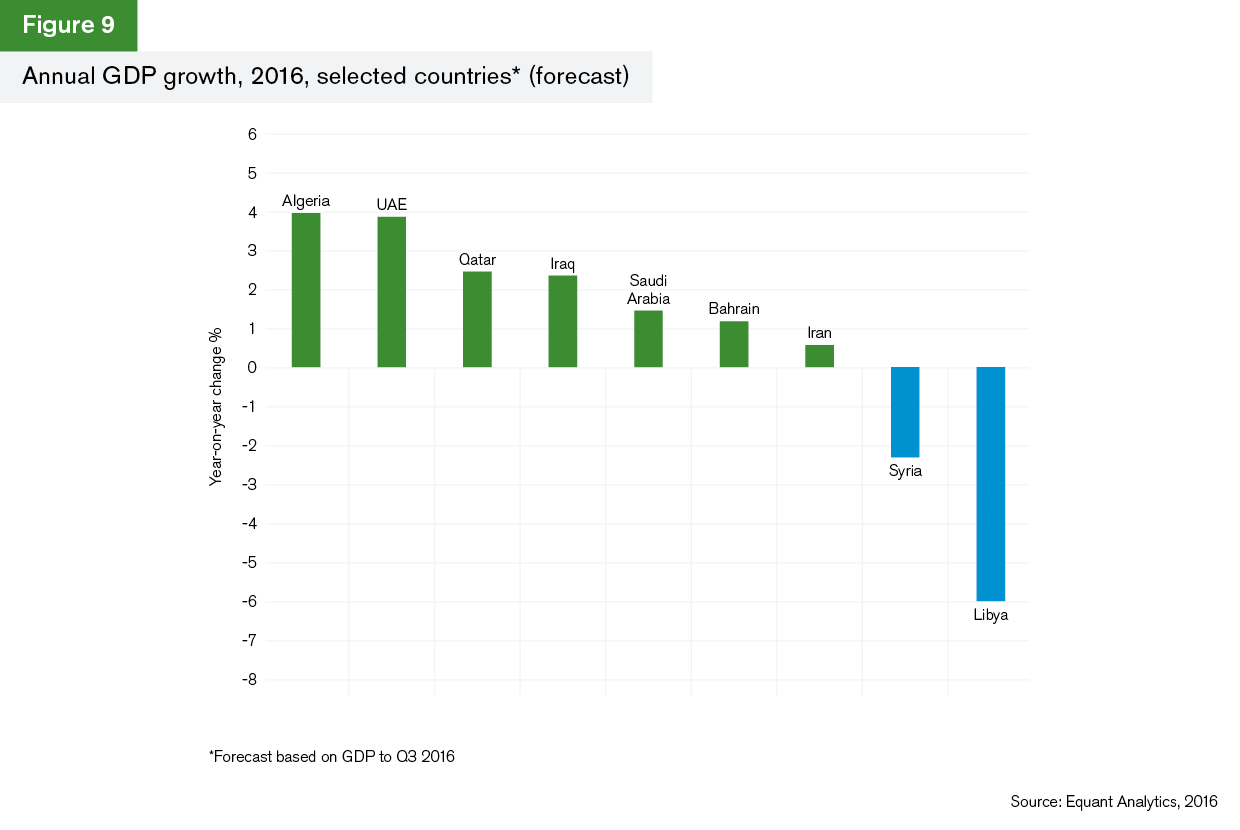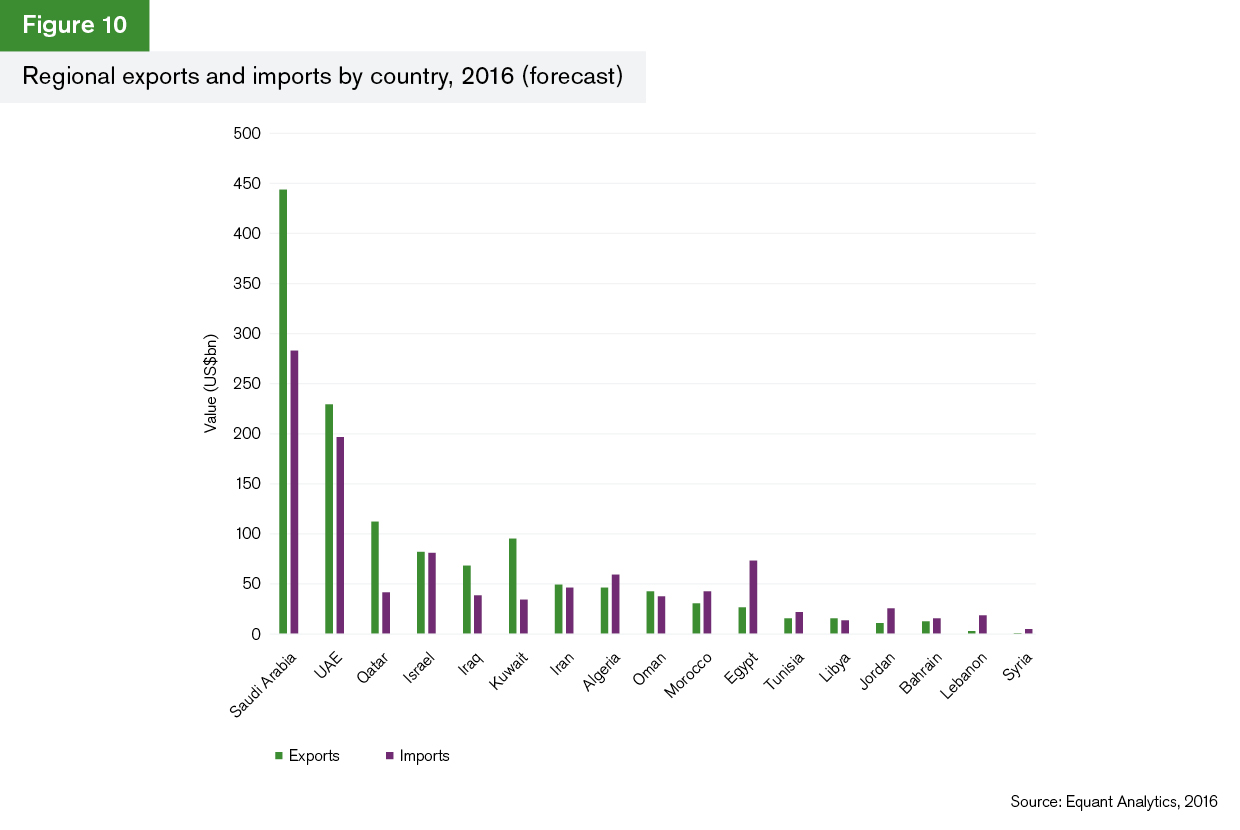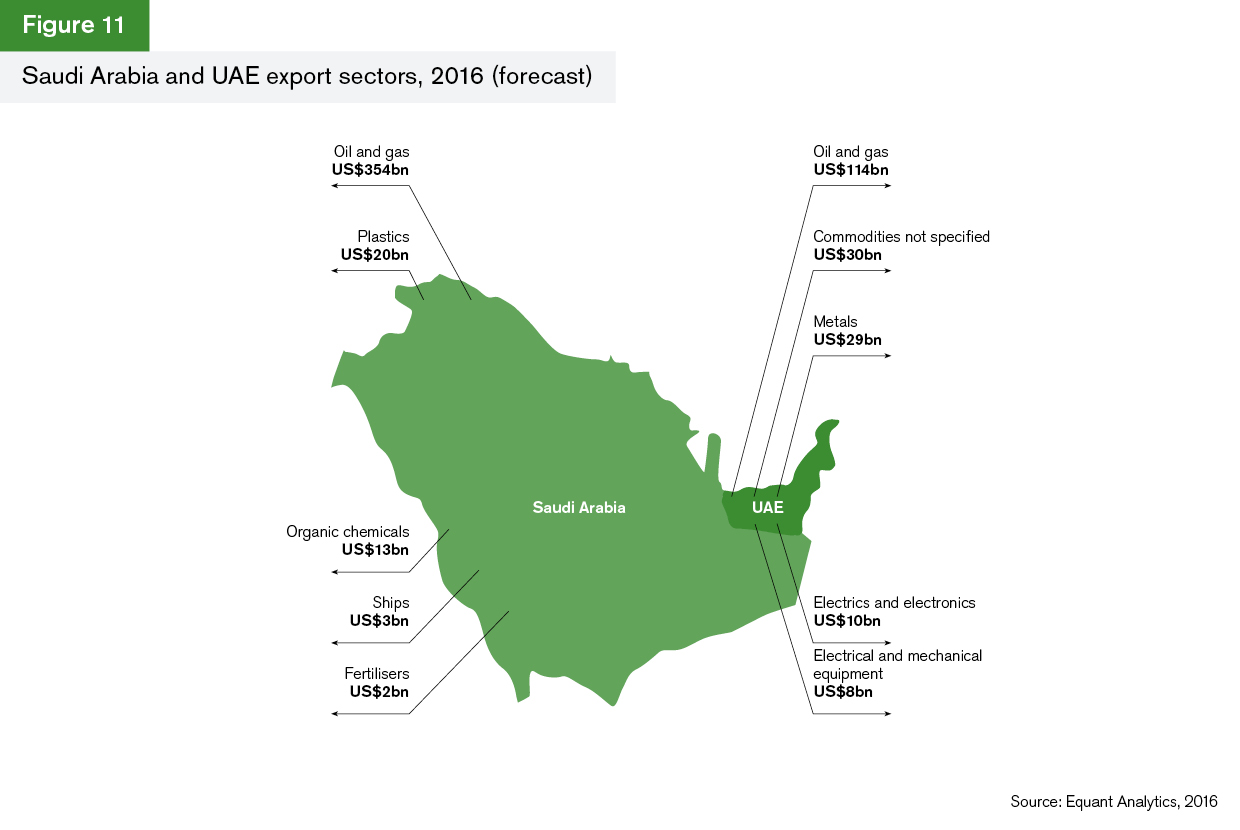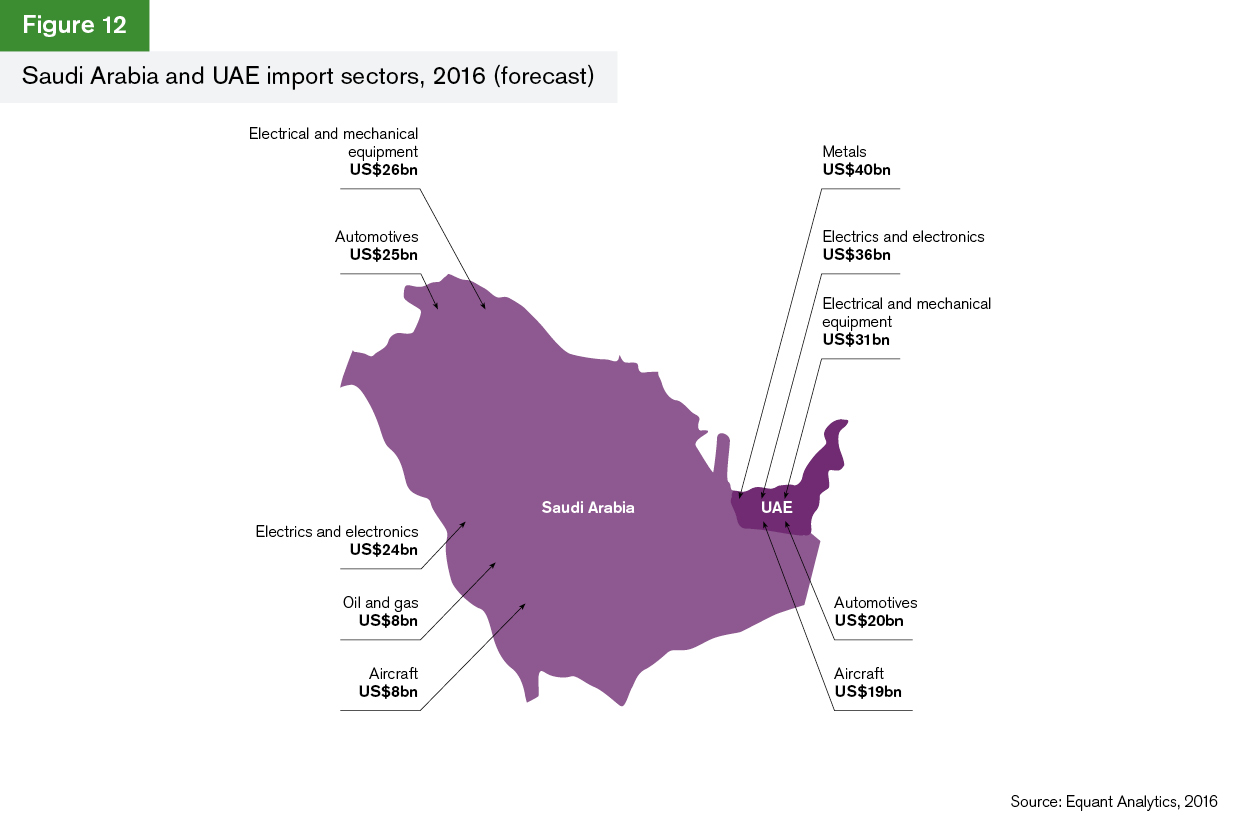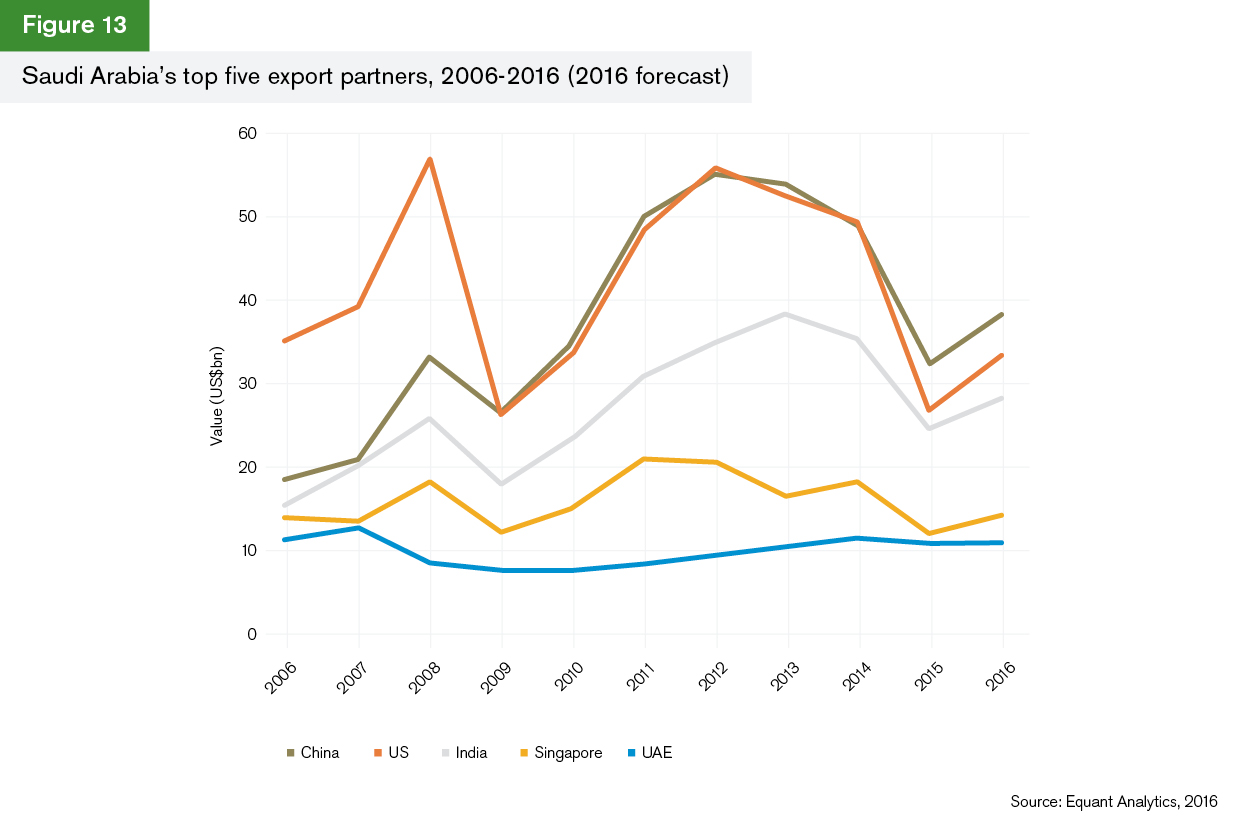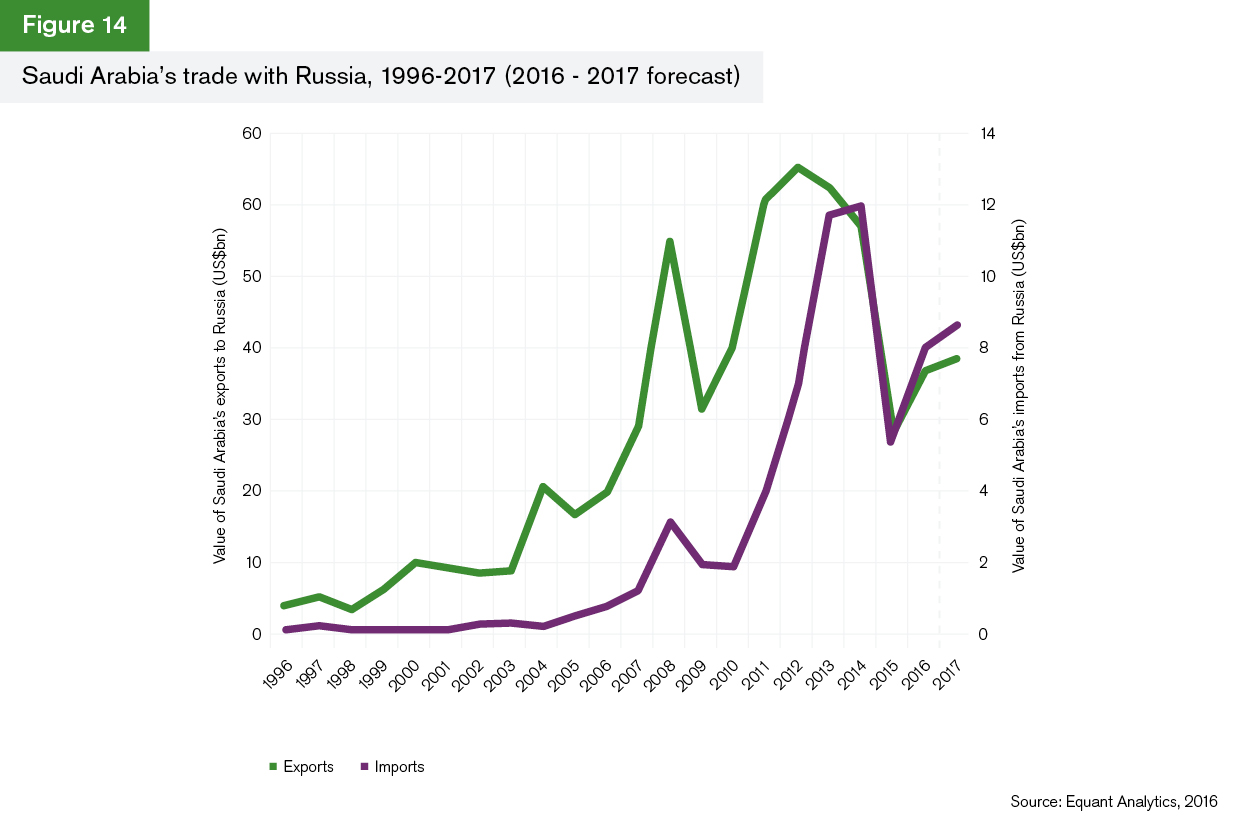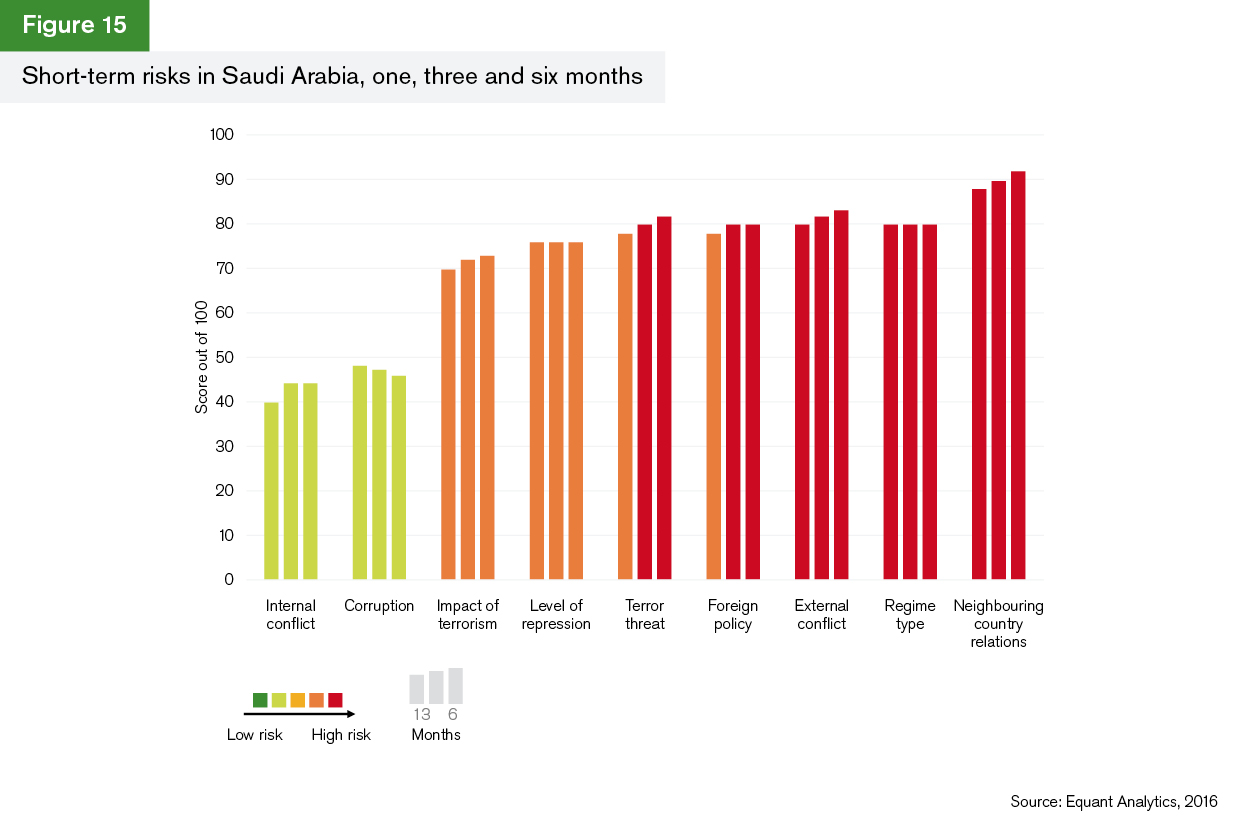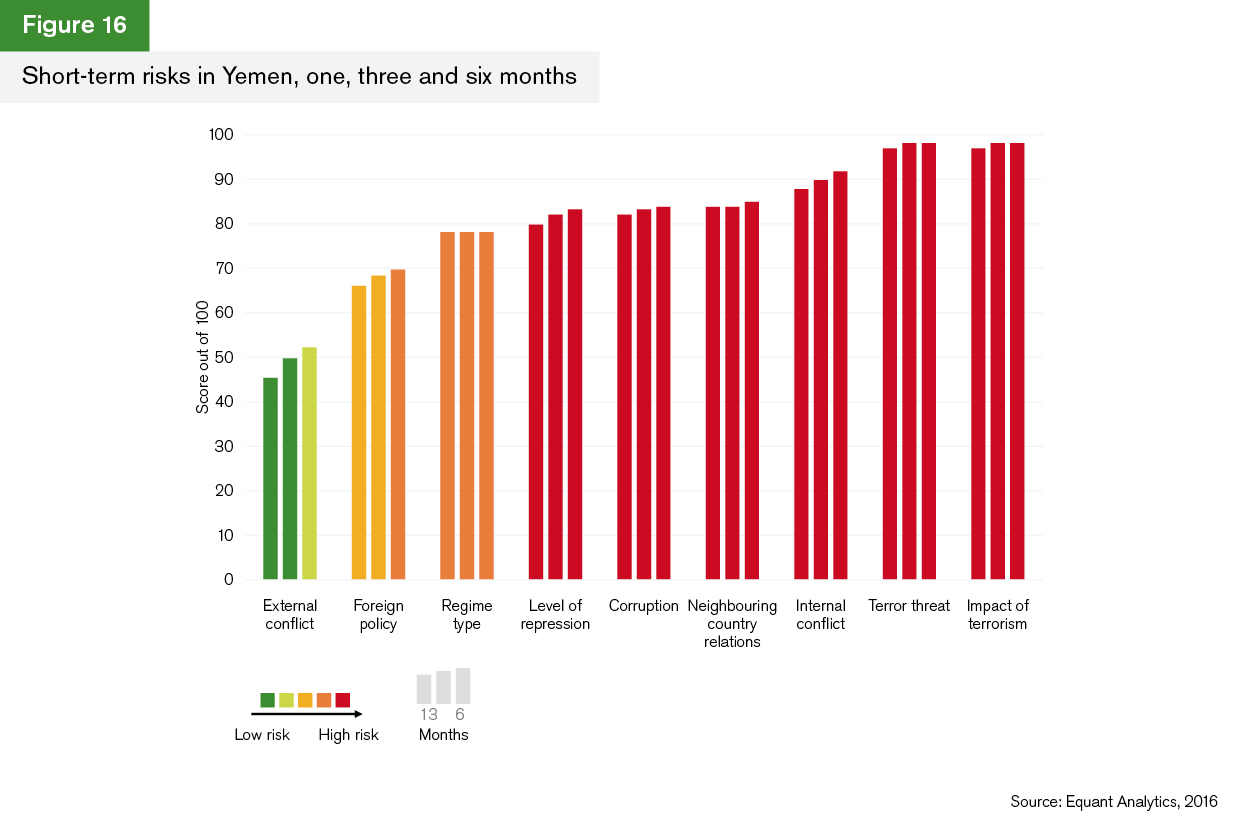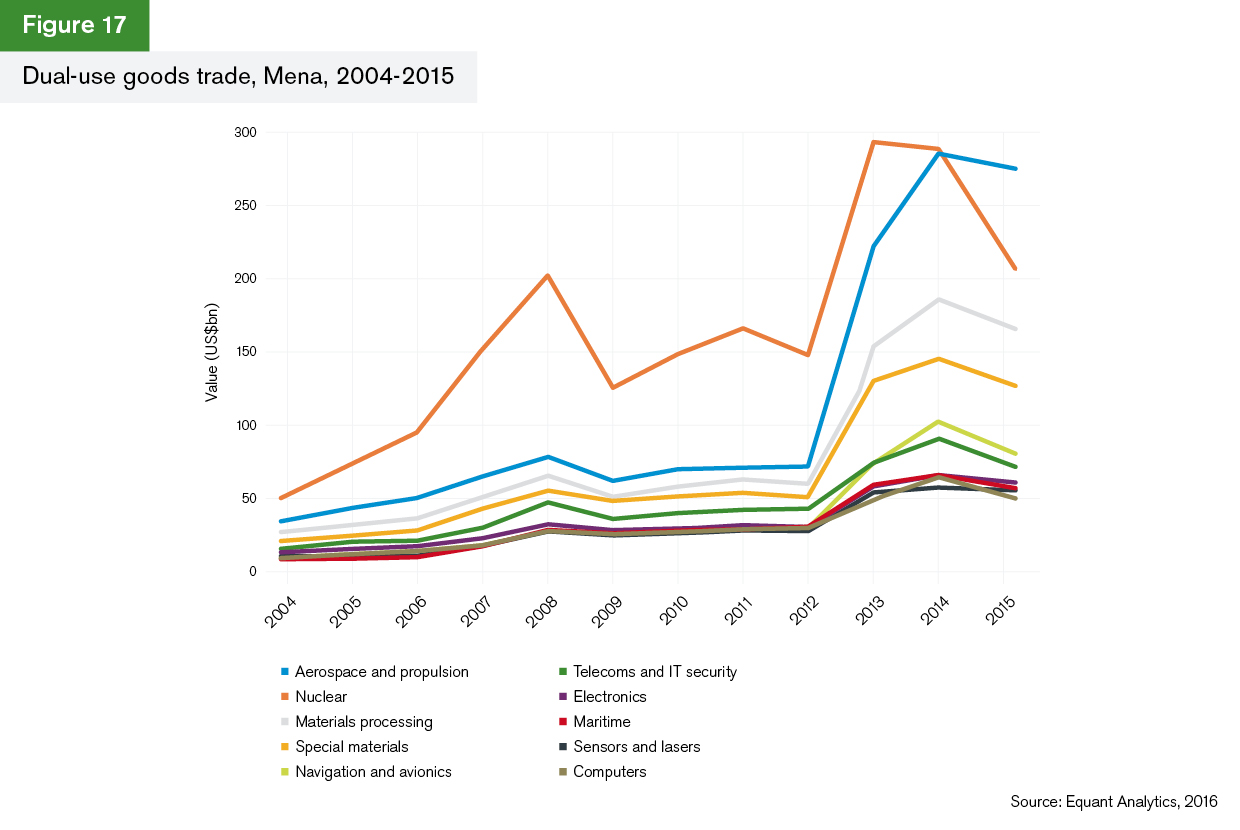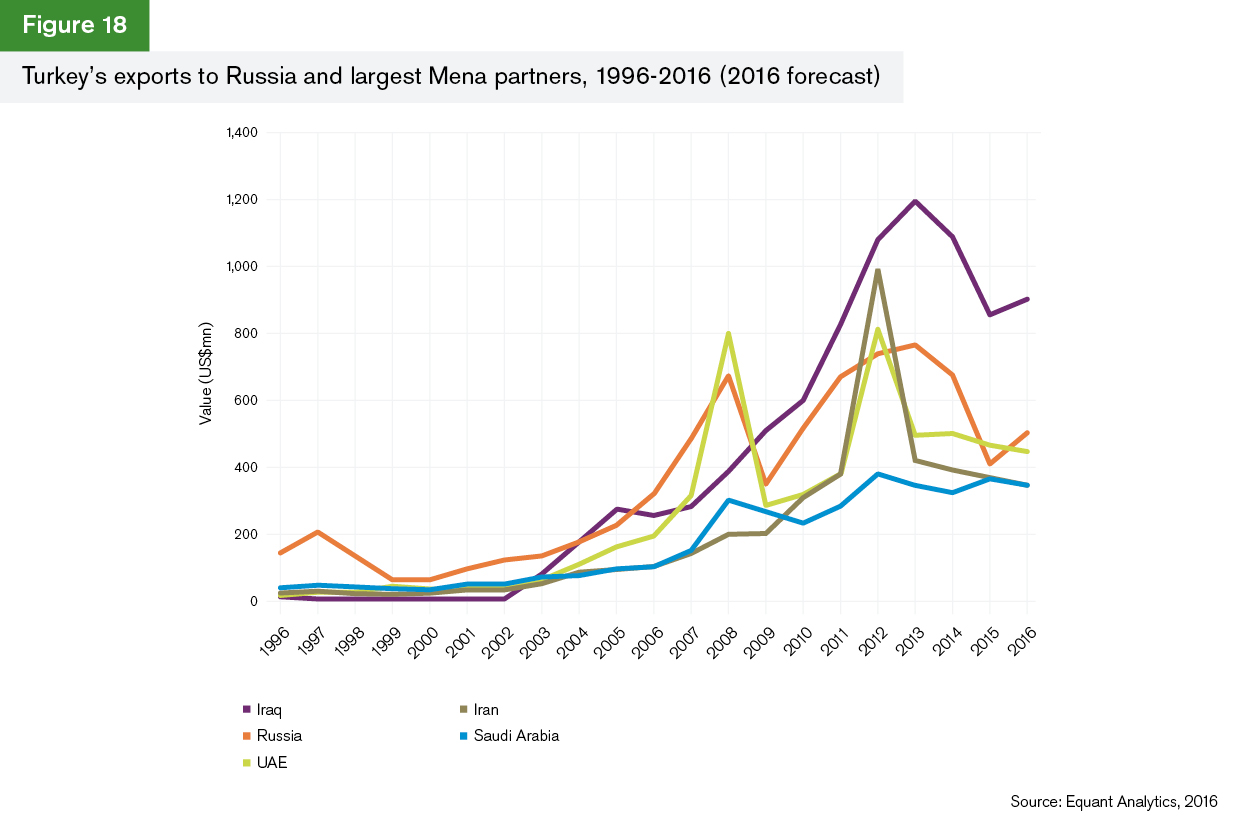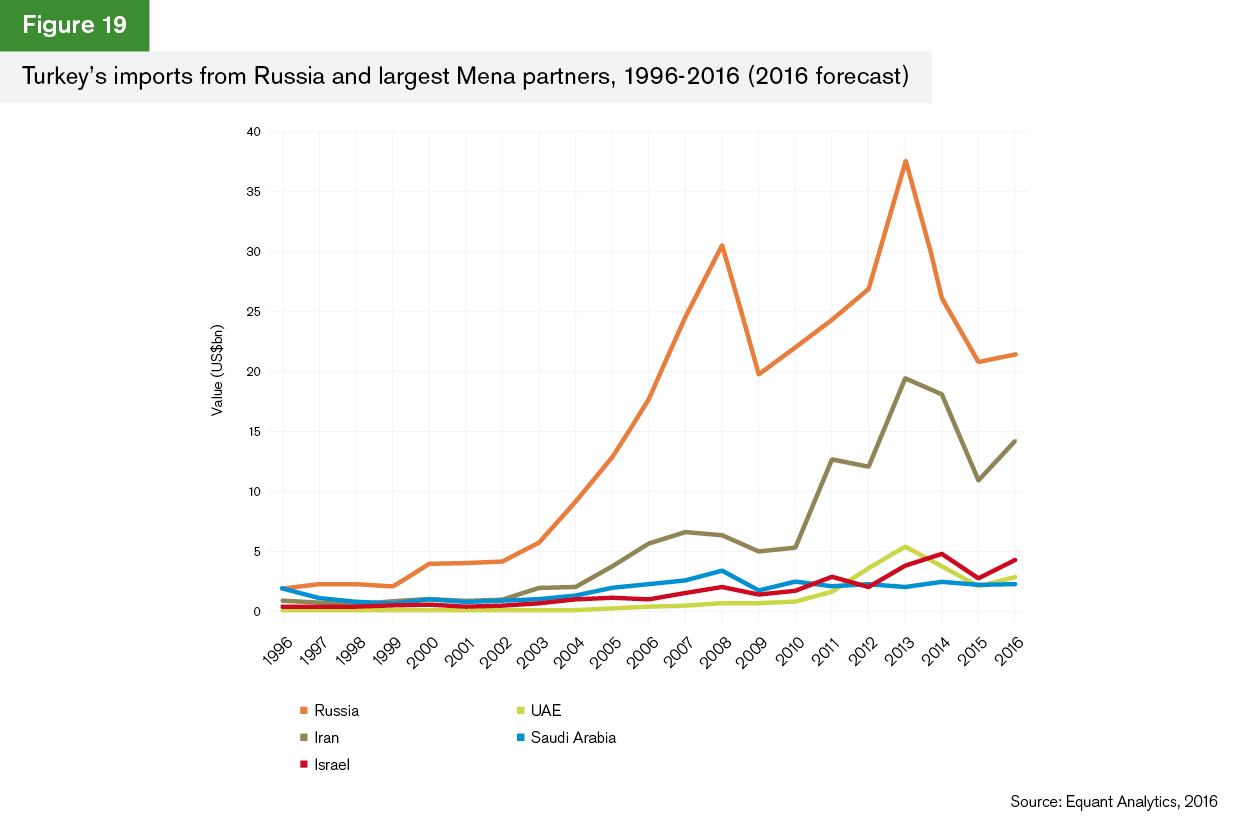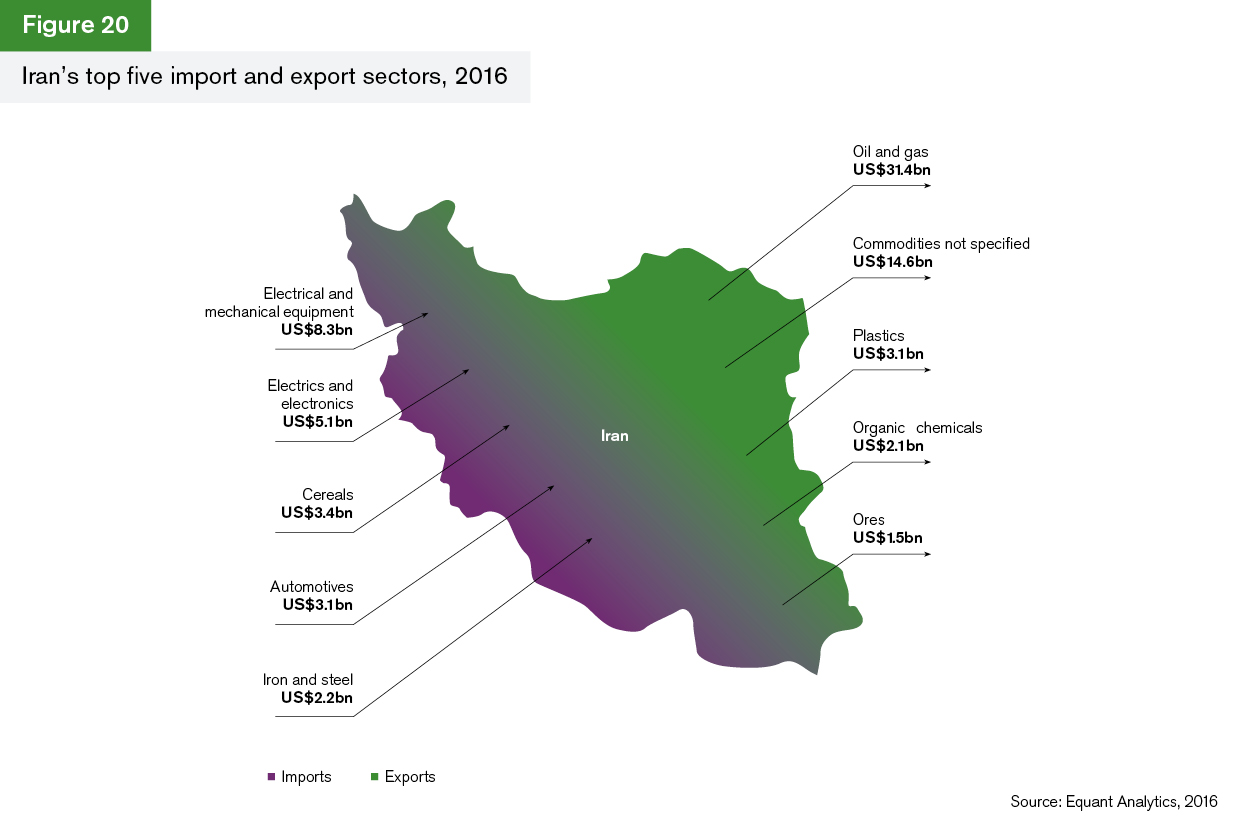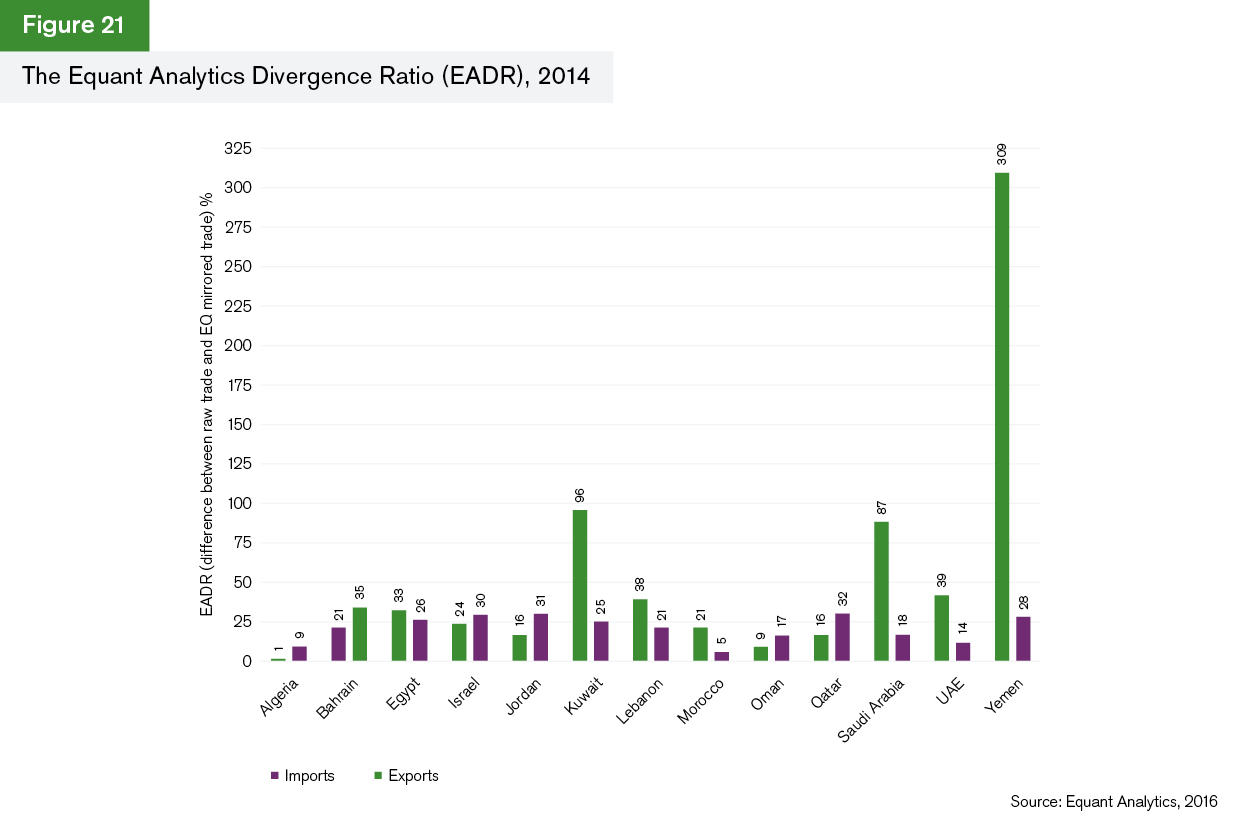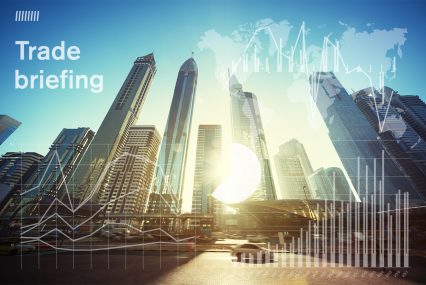
The Middle East and North Africa region (Mena) contributes in two principal ways to the global trading system: first, it is a key supplier of oil and gas to the global economy, and second, it is increasingly a global trading hub linking Europe, Central and Eastern Asia and the Asia Pacific regions through Dubai. It still has challenges to reduce its dependency on oil, but as its trade hub role grows, it is becoming more diversified and more systemically important to world trade.
The region’s economic fortunes have been intertwined with its geopolitics – particularly the role of the Organisation of the Petroleum Exporting Countries (OPEC) and its influence over oil prices. Similarly, the persistence of conflict and a lack of transparency in terms of what it trades and with whom have created a perception of risk in terms of compliance, which is hindering the efforts of individual nations in the region to integrate more closely into global trade and trade finance.
In the first briefing of its kind, this overview looks at the region’s trade in terms of sectors and partners. Data is a real challenge for Mena but, using the Equant Analytics proprietorial methods for mirroring and harmonising trade data, information is provided here that has hitherto not been available. It covers trade, trade finance, sectoral trade, hidden or obscured data and the implications of the lack of transparency for a region that needs to comply with global systems if it is to integrate fully with them.
Trade, oil and the Middle East
The Mena region constitutes some 9% of world trade (Figure 1). Saudi Arabia and the UAE are by far the largest trading nations in the region, and the dominant traded sectors – making up 30% of the region’s exports – are, unsurprisingly, oil, gold and related sectors such as petrochemicals.
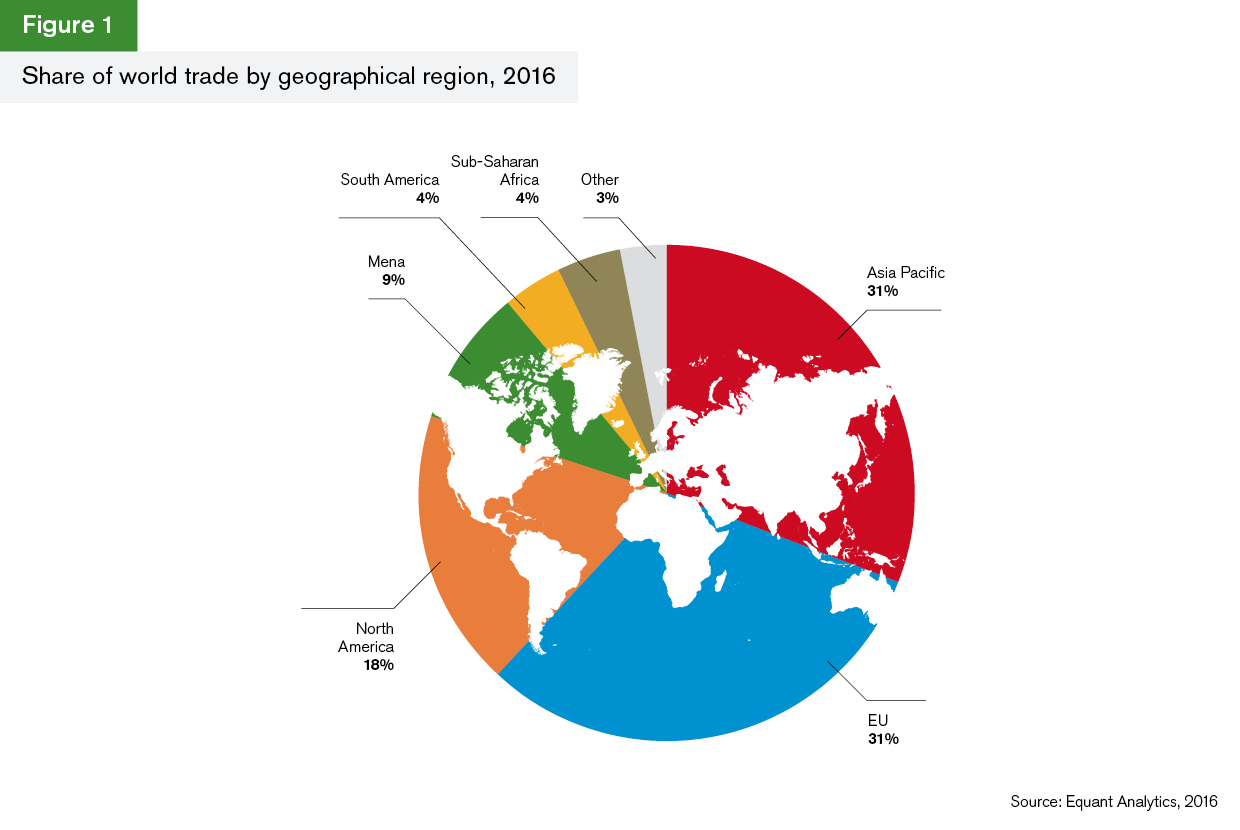
The region’s dependency on oil is both its major strength and its major weakness. When oil prices fall dramatically, as they did in 2015, the region’s exports suffer (Figure 2). In fact, 2015 was the first year since 1998 that saw the region switch from being a net exporter to a net importer and, while the trade deficit looks set to reverse back to surplus in 2016 and 2017 as oil prices improve, it has caused substantial economic challenges, and for Saudi Arabia in particular.
The correlation between the oil price and the region’s exports is 96% (Figure 3), underscoring the importance of this sector.
Mena tends to suffer more from any volatility in commodity prices than the rest of the world because oil represents some 62% of its total exports. The regional drop in the value of trade in both 2009 and 2015 was greater than the drop for the world as a whole, with a particularly marked difference in 2015 (Figure 4).
This dependency on oil prices is obvious from the sectoral profile of the region’s trade (Figure 5). Oil and gas exports dwarf every other sector and their strong growth during 2016 explains the rapid bounce-back of the region’s trade overall from the lower levels in 2015. There is little sign of regional diversification in terms of the overall structure of trade.
“Commodities not elsewhere specified” is a generic term to refer to trade in goods that are not classified. The fact that it is growing rapidly illustrates some of the need for greater transparency in the region about exactly what is being traded, since this sector itself accounts for nearly 7% of the region’s trade.
Outside of the oil and gas sector, there is evidence of growth and some diversification (Figure 6). Although this is likely to slow in 2017, the slowdown in growth is because of the rapid bounce-back in 2016 rather than a slowdown in trade overall. Interestingly, the only sector that is set to expand in 2017 is the cement, salt and stone sector, suggesting that the region’s infrastructure, and potentially its petrochemical sector as well, is likely to see growth.
There is greater evidence of diversification in the region’s imports (Figure 7). If this is a lead indicator of future changes in the region, then the rate at which infrastructure goods are being imported suggests that the region’s growth is being driven by infrastructural imports, not just in physical goods such as machinery and iron and steel, but also in computing and information technologies. Imports in information and communication-related goods (electrical and mechanical equipment) are set to grow into 2017, as are electrical goods and equipment. Physical infrastructure, such as trains and aircraft, are also set to grow. The slight uptick in precious metals into 2017 reflects a forecast for stronger gold prices as this sector is dominated by gold.
Aircraft is a large export sector, but also a fast-growing sector for imports, set to grow quickest in 2017 at 10% year on year, taking its overall import value to US$41bn (Figure 8).
The challenges ahead
The International Monetary Fund (IMF) downgraded its forecast for the Mena region in April 2016, partly because of sustained conflict in the region and also because of subdued oil prices. The region’s overall economic growth in 2016 is likely to have been positive (Figure 9) but low everywhere, except in Syria and Libya, where growth is negative.
Libya is more vulnerable to conflict and oil prices and its growth appeared to shrink by 6% in 2016. In contrast, the UAE’s annualised GDP growth was 3.9% up to the third quarter of 2016, suggesting that it is resilient both to oil prices and the perception of risk in the region.
Towards the end of 2016, commentators suggested that accommodative monetary policy and slightly higher oil prices would improve the region’s outlook, and this is reflected in Equant Analytics’ forecasts for 2016 and 2017.
However, it is important to be realistic about growth in the region. It is difficult to disentangle its economic fortunes from geopolitics in the true sense of the word. Geopolitics is the study of a country or region’s international policy and political power from the perspective of geography, including natural resources, borders and other spatial components of trade. The region itself is a collection of countries that are held together by the fact that they are oil producers and exporters, rather than by the fact that they have common political systems or shared economic interests.
2017 is likely to be a year of political uncertainty globally. In one example, the US shift in focus towards “Americanisation” rather than “globalisation” in economic terms and away from reconciliation with Iran’s nuclear programme is likely to affect the region disproportionately: any move away from free trade will affect trade hubs globally. Iran’s future as an economic centre is vulnerable to the political position of the US, and greater focus on America might mean that US shale producers take a more aggressive approach towards production, putting pressure on oil prices.
How the region faces these challenges during 2017 will be key to how it fares economically. Its individual nations are highly dependent on international trade, not just because of the wealth created by oil, but because of their need for other goods and services as well. The region’s key players are likely to react to US protectionism by accelerating their trade relationships with China and Russia, for example, and this in itself is a geopolitical move in that it has the potential to continue to re-balance trade towards the east globally.
Several factors will drive the performance of the region as a whole and of individual countries within it during 2017:
- The performance of its two largest economic players, Saudi Arabia and the UAE
- The economic impact of conflict and risk in the region
- The role of players outside of the region: the importance of Turkey to the region’s geopolitics
- The need for greater transparency both in data collection and actual regional trade if the region is to overcome challenges around know your customer (KYC) and anti-money laundering (AML) concerns in trade finance.
Each of these factors is investigated in this briefing, which concludes with a discussion on the growing importance of the service sector in the region.
Saudi Arabia and the UAE – drivers of growth and diversification?
Saudi Arabia and the UAE together account for more than half of the region’s exports and just under half of its imports (Figure 10). In both cases, the dominant sectors are oil, commodities and intermediate/infrastructure goods, constituting in both cases 10 out of the 15 largest sectors.
But there are important differences between the two countries:
- The top five export sectors for Saudi Arabia are related to the production or export of oil and gas. Surprisingly, ships are the fourth-largest export sector, but arguably this is related to moving its oil around the world.
- On the face of it, the UAE’s more diversified exports reflect its role as a hub. Electrical and mechanical equipment feature strongly but, interestingly, commodities not elsewhere specified are also a significant component of the country’s trade, reflecting, at best, poor reporting.
From this, it is hard to conclude that, in export terms, the UAE and Saudi are leading the way in terms of diversification. Any diversification is related to commodities and infrastructure. This may suggest that both countries are increasingly important as regional trading nations, hence the fact that non-oil and gas trade is now in the top 15 sectors whereas 10 years ago it was not. However, even this level of diversification is still very limited in its impact, both on the region’s trade structures as a whole and on the trade mix of the countries themselves.
Imports are substantially more diversified than exports for both Saudi Arabia and the UAE, reflecting both the role of domestic demand in each of the two economies and the broader trade hub role that the UAE, in particular, plays.
- Saudi Arabia’s main imports are related to information and communication technologies and infrastructure as well as consumer demand. For example, pharmaceuticals imports are worth nearly US$7bn. However, six out of the top 15 import sectors are oil and gas or commodity-related, with gold and precious metals featuring strongly.
- Four out of the top 15 of the UAE’s imports are commodity-related and again, gold and oil play an important role. However, just over US$11bn of the UAE’s imports are in goods not elsewhere classified, again suggesting poor reporting of inbound and outbound trade.
Trade diversification in the region’s two largest trading countries is limited to imports, and even here, commodities and infrastructure still play an important role. However, it reinforces the fact that the economic fortunes of the region and its key traders will be interwoven with commodity prices.
Saudi Arabia is a particularly good case in point. It has sought to diversify, and the importance of petrochemicals and ships in its export profile gives some indication that it is being successful. Similarly, it is increasingly exporting computer equipment (classified as electrical and mechanical equipment) as well as wider infrastructural goods.
But its dependency on oil, particularly in the short term, while it builds a more diversified trade profile, has meant that its trading partners have shifted. Where a few years ago the US was the leading export destination, China has now taken the number one slot (Figure 13), with the US and India second and third respectively.
In 2006, the US was substantially more important than China as a trading partner for Saudi Arabia. However, its trade with China did not fall back as substantially during the financial crisis of 2008/09 and although the US received roughly the same level of exports from Saudi Arabia up to 2012, the kingdom’s trade with China has been greater for most of the period since.
Russia does not feature in the region’s top export or import partners and yet, as Figure 14 shows, it is growing in importance as a destination for Saudi Arabia’s oil exports. The growth was particularly marked up to 2012 but volatile oil prices as well as economic difficulties in Russia have made the relationship erratic since. It does appear that imports from Russia in particular have been growing rapidly (albeit from a lower base) and while it is too early to claim that this is a “shift” to the east by itself, it does suggest that Saudi Arabia is developing stronger ties with its non-US partners.
The impact of conflict and risk for the Mena region
The fact that Saudi Arabia is trading more with China than it is with the US, and that this gap is widening, underscores both the shift in geopolitical focus of individual countries and the inherent vulnerability of the region to risks. These risks, as has already been made clear, are centred on the oil price (and commodity prices more generally) and the risk of conflict. Conflict itself may not make countries like Saudi Arabia, the UAE or Qatar less stable or competitive, but it does weaken the performance of countries like Libya and Syria with knock-on effects across the region.
This is illustrated in the cases of Saudi Arabia and Yemen – despite being highly stable, Saudi Arabia is currently at risk from the escalation of tensions, and therefore spillovers, from Yemen.
The approach looks at the short-term risks, particularly those covered, for example, by a 90 to 120 day letter of credit in terms of various security threats, including those of state strategy, terrorism and corruption, all of which are central to the trade finance context.
Saudi Arabia
Key risks (70.9/100):
- High threat of terrorism
- High level of tension with Iran
- Currently leading coalition in Yemen
- Political and economic uncertainty
- Southern provinces bordering Yemen subject to sporadic rocket fire
Saudi Arabia has a highly centralised political system currently headed by King Salman bin Abdulaziz. The Saudi government has a tight grip on power and does not tolerate dissenting voices. For example, after a relatively swift dealing with the Arab Spring protests in 2011, Saudi Arabia then dispatched security forces to deal with the uprising in Bahrain. This affords the country a great deal of political stability, although issues of human rights abuses are often raised by its western allies.
Geographically, Saudi Arabia shares borders with Yemen to the south and Iraq to the north; these borders present a significant security challenge, as reflected in the map. For example, a recent rocket attack by Houthi rebels in Yemen exploded across the border in Najran, killing five Saudis.
Geopolitically, the greatest risk to Saudi Arabia is rising tensions with Iran. Apart from the fundamental religious divide between Shia Iran and Sunni Saudi Arabia, recent tensions are a result of the civil war in Yemen, which has become a battleground for their competing interests. Saudi Arabia is currently leading a coalition against the Iran-allied Houthis and has accused Iran of providing financial and military support to the rebels.
Meanwhile, there has been a shift in rhetoric from Tehran: with President Hassan Rouhani recently referring to Saudi policies as “divisive” and as spreading the “ideology of hatred”. The lack of conciliatory or constructive dialogue between the two powers will only prolong regional unrest and fuel the potential for a “hot” conflict between the two.
Yemen
Key Risks (80.6/100):
- Full-scale civil war since March 2015
- Yemeni government disbanded by Houthi rebels
- Yemen being used as proxy conflict between Iran and Saudi Arabia
- US engagement through airstrikes since October
- Strong al-Qaeda presence still exists
In January 2015, a long-running, low-level Houthi insurgency escalated when they captured several western territories and laid siege to President Abdrabbuh Mansour Hadi’s residence in the capital, Sana’a. Hadi was placed under house arrest and forced to dissolve the government before managing to escape. By March that year, the situation was officially referred to as a civil war. Saudi Arabia initially carried out a series of airstrikes before a ground invasion as part of a Saudi-led coalition.
Casualty statistics differ, however conservative estimates are that so far around 7,000 people have been killed, with a further 3.2 million people displaced. The humanitarian situation in Yemen is extremely serious at present and, as the map above shows, no area can be considered safe. Houthis dominate the west of the country, while forces loyal to Hadi control most of the east. However, an ongoing al-Qaeda insurgency is an additional complicating factor. Al-Qaeda has a strong presence in the Hadhramaut governate and, until recently, had control of its capital, Al Mukalla.
The conflict also has implications for regional security and stability as Yemen becomes a battleground for Saudi Arabia and Iran’s competing interests. Geographically, Yemen shares a border with Saudi Arabia and is therefore firmly within its sphere of influence; however, Houthi control of north-western territory has serious security implications for Saudi Arabia. The Houthis identify as Shia, the main religion of Iran. Although Iran has not revealed the extent of its involvement in the conflict, a statement by an Iranian general that Iran would aid the Houthis “in any way it can” was at least an admission of support for their campaign.
Given the fragmented political landscape in Yemen and confusion from the international community over who controls which areas, a swift end to the conflict is unlikely. In the short to medium term, temporary ceasefires or lulls in fighting are unfortunately more probable than lasting peace plans.
Dual-use goods and regional risk
The previous analysis shows how even a stable country like Saudi Arabia, which is the largest trader in the region, can be interwoven into regional conflict. This is a product of history and religion and is not the subject of discussion here. However, it does create a very high perception of risk in the region.
The best way of illustrating this in trade terms is through trade in dual-use goods – those that can be used for both civilian and military purposes.
Figure 17 shows how trade in these sectors has escalated, particularly between 2012 and 2014. The drop in the value of trade in 2015 reflects a broader decline in global trade caused by the general slowdown in trade (around 14%) and lower commodity prices. Similarly, the drop in 2009 reflects the decline in trade values following the financial crisis.
In contrast, over the whole period since the second Gulf War, trade in dual-use goods has increased substantially: for example for aerospace at an annual rate of 20% over the period and for nuclear at an annual rate of 13%.
These figures are deliberately aggregated and taken for the region as a whole. Dual-use goods are not necessarily hiding crime or covert trade and, as their name suggests, could be entirely for civilian purposes. However, what it does show is two things: first, the extent to which the region’s trade is defined by sectors which present a risk for trade finance practitioners, and second, the extent to which this is associated with increasing geopolitical risks and conflict within the region. Both of these may serve to underpin concerns around AML and KYC with the region.
Methodological note: The dual-use goods trades are calculated from the EU correlation tables for dual-use goods applied to the Equant Analytics HS code six digit trade data. This overestimates the trade values since the dual-use goods correlation tables are also at 8 and 10-digit levels. The trends are consistent with 8 and 10-digit level analysis. These sectors are aggregated to the 10 sectors highlighted above for ease of interpretation and in line with EU aggregation techniques.
Non-regional players: why Turkey is more than a flashpoint
The geopolitics of the region extends beyond its borders. Turkey, as a conduit for conflict through Kurdish separatists and links to IS, is something of a fault line on the edge of the region. This is clear in its trade, which is highly dependent on both Iran and Iraq. It ranks in the top 10 import and export partners of nearly every individual country within the Mena region but is first and second for imports and exports in Iran and Iraq.
This has made it a useful channel for oil from these two countries during, respectively, sanctions and conflict. Figure 18 includes Russia for illustrative purposes but Iraq is Turkey’s largest export partner compared to both Russia and the rest of the Mena region. Turkey’s exports to Iran dropped back sharply during the most recent tightening of sanctions in 2012.
However, there does not appear to be a lasting effect of tighter sanctions on Iran after 2012 on imports into Turkey. Although Iran’s exports to Turkey have fallen back, at least some of this is due to the drop in oil prices. With the prospect of sanctions softening between 2015 and 2016, it appears that imports from Iran are once again gathering pace.
This is evident in the sectors that Turkey trades with Iran. Of its top five trade corridors with Iran, three are imports: mineral fuels, plastics (petrochemicals) and copper. The other two are Turkish exports of gold and electrical and mechanical equipment (largely computers) (Figure 20).
The region’s hidden trade: why this matters to trade finance
Turkey’s trade with Iran serves to illustrate the complexities of Mena’s trade with the rest of the world: much of it is concealed behind sanctions, poor reporting and, as the dual-use goods chart suggested, potential fraud and crime.
To assess how important this is as a phenomenon, Equant Analytics uses its proprietorial data cleaning and mirroring methodology to find the gaps in the data. The Equant approach looks at “raw” data registered with international bodies like the World Trade Organisation and the United Nations Comtrade. It integrates the publicly available data onto one platform and then looks at trade flows for each country. In other words, it looks at Saudi Arabia’s trade with Germany and Germany’s trade with Saudi Arabia and takes an average point of that value weighted in favour of the better reporting country.
Globally, this technique uncovers US$2.1tn of additional trade. Given that many of the countries in the Mena region are so poor at reporting data, it is little surprise that the average divergence between what countries in the region report is nearly 40%, or US$385bn-worth of imports and US$517bn-worth of exports. Much of this is oil trade and, since there has been no official data for many years for both Iran and Iraq, it could potentially be explained simply by these omissions (Figure 21).
The fact that the trade data diverges in this way matters for the region. It suggests a degree of hidden trade which, although by definition concealed within the data, may indicate greater risk for trade finance providers. The importance of “goods not elsewhere classified” in the region suggests that some trade is not being adequately reported. The rapid acceleration of dual-use goods trade suggests that there is not just an increased risk of conflict but also an increased risk of fraud since these goods are associated with fraud and crime.
Individual countries within the region are seeking to improve both trade finance and trade integration to allow their own companies and companies from across the world to take advantage of the region as a gateway between the “north” and the “south.” They can greatly improve their prospects of achieving these goals by tightening trade reporting.
Methodological note: The EADR is the percentage difference in any one year between what a country records as its trade with the United Nations and what Equant Analytics finds that it actually trades by mirroring its trade data with each of its individual partners. The mirroring technique is one developed and used by both the World Trade Organisation and the OECD, however, the weighting process, based on an analysis of the reliability of the data in the country or sector pair from the start of the time series, is proprietory to Equant Analytics.
Concluding remarks: services and trade finance
The region’s services trade, which largely constitutes financial services, suggests that there is some diversification that is not being picked up in goods trade data. Substantial service sector import growth in Saudi Arabia and the UAE reflects ongoing inward investment in financial services despite sluggish economic growth, particulary in Saudi Arabia. The UAE is exhibiting the largest services export growth in the region after Bahrain (Figure 22), and, as it is also the largest exporter, this is significant. It reflects the growth of the UAE as a financial services hub and as a global port.
Bahrain’s growth in 2016 appears exponential and is to a large extent the result of rapid growth in Islamic financing. However, the absolute change should be treated with some caution: the numbers are very small and the previous year showed a sharp decline which reversed in 2016. This is a function of the volatility of oil trade-related financial services.
Bank-intermediated trade finance in the region, whether for trade that originates in Mena or just passes through it, is estimated at US$580bn in 2016. Commodities and specialist trade finance associated with infrastructure development are particularly important to the region and between them constituted around US$871mn, also in 2016.
Specialist trade finance is especially vulnerable to the strictures of risk and compliance regimes and there are several risks that may inhibit the amount of global trade finance coming in. These are clear from the discussion above:
- Dependency on oil prices: This report has identified small-scale diversification away from oil and gas in some of the smaller countries in the region and in the UAE, because of its role as a trade hub. However, this dependency is likely to take a long time to dilute and, while it does, key players in the region have started to look increasingly towards China for oil export income. China’s growth into 2017 is not assured given its sluggish performance, and this remains a challenge to countries like Saudi Arabia.
- Geopolitical risks: The region is defined by its conflicts, both historical and religious, and economic (through oil). These risks do have spillover effects on other countries in the region, as illustrated by the case of Saudi Arabia and Yemen. Saudi Arabia’s weak economic performance over the last couple of years is at least a product of oil price dependency and continued political risk. Similarly, global sanctions regimes are becoming less clear in the wake of the presidential election of Donald Trump in the US. Investment has already started to flow into Iran and the danger is that this uncertainty will restrict trade and trade finance during 2017.
- Country risk: The region is very dependent on selected external countries and Turkey has been used as an example to highlight this. Turkey has been a conduit for sanctions-induced trade diversion, particularly for Iran. However, Turkey also represents something of a fault line for the geopolitics of the region and this presents risks to growth not just for Iran and Iraq but also for major players like Saudi Arabia and the UAE.
- Data risk: Poor data reporting has resulted in “hidden” trade in the region of over US$500bn in 2015. The rapid increase of dual-use goods trade, and the fact that “goods not elsewhere classified” constitute 7% of the region’s trade, reinforces a lack of transparency in the region that may do long-term damage to a KYC and AML-driven compliance regime globally.
Nevertheless, there are a lot of positives that come out of this research. Mena has recovered well from the drop in trade in 2015, and while the IMF downgraded its forecasts for economic growth in the region, the Equant Analytics momentum forecasts for trade in 2017 suggest that there is scope for optimism. Services sector trade, especially in Bahrain, UAE and Saudi Arabia, is growing strongly.
The region looks set for a positive 2017. But to maintain that outlook into 2018, data collection should be improved and recorded in a more structured way in order to overcome risk perceptions.
Methodology
Overview
Equant Analytics provides datasets of global trade flows covering the time period 1996 to 2020, with annual and monthly data from January 1996 to the current month. The data cover import and export flows for 200 countries by partner, sector and partner-sector trade routes. The goods dataset uses OECD mirroring techniques to ensure that bilateral trade flows are identical. For example, exports of oil from Saudi Arabia to Germany will have the same value as imports of oil into Germany from Saudi Arabia.
Data refinement methodology
Equant Analytics uses the UN Comtrade statistics as the main source of comprehensive and detailed information on international trade. The UN Comtrade’s database provides information as it is reported by country authorities and does not apply any data integrity verification or missed data filling. Consequently, the raw UN Comtrade dataset presents the following relevant issues:
- Absent or sparsely reported data for many countries and territories, especially in Africa, Asia and Latin America
- Large asymmetries in bilateral trade values reported by a pair of countries
- Partly disclosed information due to statistical confidentiality (relevant especially to the arms trade and sanctions regimes)
- Classification reporting and conversion issues (UN Comtrade does the conversion between different classifications, based on the most detailed layer of the classification, while some information can only be reported on an aggregated level)
- Delayed reporting and past information amendments by some countries
In order to build consistent international trade data and increase its coverage on the bilateral level to the extent possible, Equant Analytics shares the trade mirroring approach used, in particular, by the OECD.
This approach uses the information reported by partner countries to resemble and verify the reporter’s data as well as to fix the asymmetries. Mirror statistics are mostly helpful for small and medium-sized trading countries, where there is no reported data available or the data is very sparse. However, in many cases they help to reveal some systematic trade underestimation for some well-established reporters, or information which was not disclosed.
Equant Analytics implemented the trade mirroring algorithm for the UN Comtrade Harmonised System (HS) classification, revision 1996, as follows:
- Trade mirroring applied for each trade flows between all the reporting countries and territories.
- Simple trade mirroring is done for cases when the trade is reported only from one of the sides.
- When a trade is reported by both sides and there is an asymmetry, the common trade value is calculated as a weighted average of the two reported values. The weights are defined in accordance with the country reporting reliability index, developed by Equant Analytics.
- If the asymmetry is extremely high, the lower value is assumed to be underreported, and the resulting trade value is set to the higher declared figure.
- The resulting trade values on 2 and 4-digit levels, calculated for the HS 1996 classification are compared with those for HS classification used when reporting (normally country statistic offices report in the most recent classification for the year, and this information is converted to previous versions of HS classifications with certain losses, related to detailed data disclosure). If the difference between the trade value in HS 1996 and HS ‘as reported’ is higher than 40%, the former is assumed to be wrong and the HS ‘as reported’ value is taken as the best estimate.
- When the whole dataset is processed for a single year, country total imports and exports are calculated for the refined trade values for each commodity group, and the total cumulative import and export values are obtained for each country and the world.
The resulting ‘refined’ dataset appears to be the most complete of the available source data, and features the following attributes:
- Provides best available estimates of aggregated trade statistics, where they were not reported or significantly distorted
- Gives an indication of hidden trade flows and the true state of trade relationships, when the ‘refined’ values diverge significantly from the ‘raw’ figures. The amount of hidden trade can be estimated as the difference between the two on a commodity or aggregate levels.
- Is import/export consistent: each country import value is equal to the counterparty’s export value for every commodity group/classification code, and the global import total converges with
the export total.
Trade forecast methodology
Equant Analytics employs a momentum-based forecasting algorithm in order to produce trade value forecasts. The method below is generic as applied to a longer time period. The forecasting method features the following concepts:
- Analyses dynamics of differentiated time series with 10-year historical horizon, applies outliers filtering and absent data filling.
- A double momentum forecast: the first taking a 10-year moving window and the second a three-year moving window.
Disclaimer
Any data or information provided in this publications is for illustrative purposes only and does not represent investment advice or recommendation. All efforts are made to ensure that data and information are accurate and reliable at the time of delivery. Any divergence of the data from other publicly available sources or from material available on Equant Analytics data platforms is due to rounding or use of alternative methodologies. These are made explicit in the text.
Rebecca Harding, CEO, Equant Analytics







